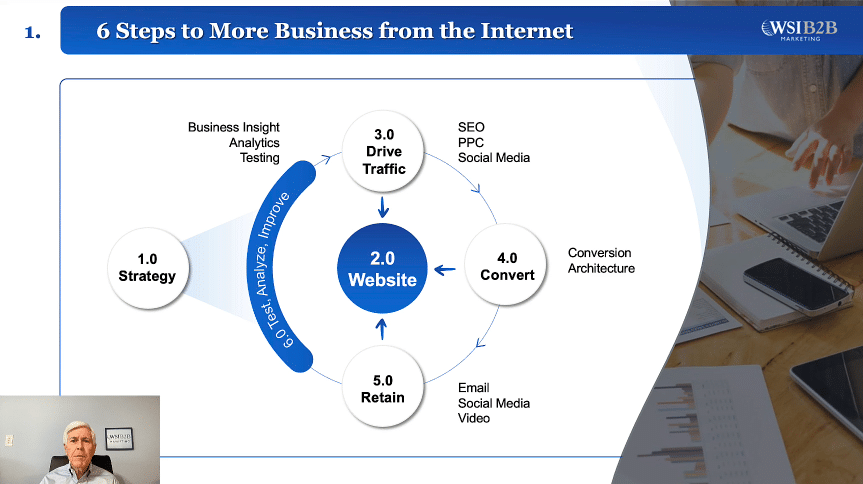A Guide to Beginning a Successful Industrial Marketing Campaign
March 24, 2021
Aside from traditional marketing plans, one of the most successful ways to drive customers to your business and attract qualified leads and sales is through digital industrial marketing. There are a number of different tools for industrial marketing teams to take advantage of, everything from SEO tactics, to content creation and website design. However, for companies that may have been doing things the old-fashioned way for a while, switching to a digital marketing plan overnight is easier said than done, which is why the team from WSI B2B Marketing is here to help streamline the process.
Where Do You Begin?
For those considering industrial marketing services for the first time, you’re likely wondering where to begin. Often, there’s a misconception that digital marketing is specifically aligned to consumer goods and business-to-customer relations, but in the industrial sector, this isn’t entirely the case. With the recent focus on e-Commerce tactics and increased sales technology, more industrial manufacturers are now seeing how important an aligned digital marketing strategy is to their bottom line.
What Exactly is Industrial Marketing?
Before getting into the more complicated details, it’s always a good idea to have a general sense and scope of what industrial marketing entails. In the simplest terms, B2B marketing or industrial marketing is the marketing of goods and services between businesses before the consumer even sets their eyes on them. This means that you’ll be advertising to original equipment manufacturers (OEMs), suppliers, or wholesale buyers.
One of the primary factors that make industrial marketing unique when compared to traditional sales marketing is the varying length of sales cycles involved in the manufacturing process. With the manufacturing sector, sales can involve larger orders and, in many cases, a long-term relationship that could last months or upwards of years. So, your goal as an industrial digital marketer is to wind up at the top of those client lists more quickly than competitors.
6 Steps for Optimizing Your Industrial Marketing Strategy
Whether you’re still doing a few things the analog way, like sending out mailers or attending trade shows, there are still a lot of ways you can streamline your digital marketing strategy for the best results online, including:
1. Assessing Your Current Strategy
Before making any plans, it’s first prudent to see what types of industrial marketing practices you already have in place, and which ones are working and which need room for improvement. As mentioned above, there are more traditional methods from mailing out pamphlets to more modern ones, such as optimizing the pages of your website. Over the years, you’ve also likely collected a lot of data you can share with customers about your business, such as graphs, charts, and calculators.
So, take all of this into account and see what you’ve accomplished with your current industrial marketing plan. Are there areas where you can improve and help attract more buyers to convert into customers? If the answer is “yes,” then it’s time to start making your ideal industrial marketing blueprint.
2. Identifying Your Key Consumer Persona
You can put all the work in the world into a marketing plan, but it won’t mean much unless you’re reaching your ideal audience. Basically, your target personas are the people you want to connect with and eventually buy your product or service, so this takes a lot of research to identify precisely who you’re trying to reach. These personas will vary from personality to industry, job function, and more. If you align your industrial marketing tactics with these personas in mind, you’ll yield the highest conversion rates, qualified leads, and increased sales.
A few things to ask yourself when performing audience and consumer research are: who is your top customer? What type of duties do they have in their current job? Are you able to easily pin down their personality? Ultimately, you should have basic information about their:
- Strengths
- Weaknesses
- Goals
- Objectives
- Personality
The more info you can collect about them, the more your sales team can engage with them on a personal level.
3. Outline Your Goals, Expectations, & Reporting Methods
When it comes to industrial marketing, data and analytics are two of the most important components of any campaign. This is because these components are how you track the success of your marketing efforts with clear, definitive numbers that can demonstrate to executive-level personnel the return your company is getting on its investment. Once you’ve outlined goals, expectations, and the audience segment you’re trying to reach, it is important that reporting is the next step and is completed as soon as possible. Be sure to set up analytics and reporting methods that can provide easy-to-digest data that is concise, relevant, measurable, and relevant both long and short-term.
A few of the best metrics to track are:
- Landing Conversion Rates: Often, landing pages will be optimized to collect the data of those who visit said page, providing further information for tracking down leads and letting you know what pages are working better than others. Additionally, if you contain a form fill page on your site, you’ll also be generating some qualified leads to follow up with.
- Website Traffic: Tracking the traffic that comes to your website and where it comes from can help you determine where the largest segment of qualified audience members are located (i.e. industry, social media site, etc.). You can also find out if you’ve been getting referrals from other sites, whether a particular visitor found your page using an organic search, and the success of your paid campaigns (social, PPC, etc.).
- Cost Per Lead: Tracking where your leads come from can help you determine what your average cost per lead is. Are they coming from a PPC campaign? Or a social media promotion? Collecting the cost per lead will help you identify your most successful marketing platforms and tactics.
4. Optimizing Existing Marketing Tactics
These days, few companies survive without doing at least some type of marketing, so take a look at what you’re doing to see how successful your current strategies are. If your webpage doesn’t rise to the top of the searching rankings, optimizing it for speed and SEO are some of the ways to easily do this.
Additionally, you can create new landing pages with forms to collect the information of potential leads before you provide them with information (like downloading a free eBook or something of the sort). Running a blog with unique, keyword-laden content is also another idea, or designing pages for specific segments or your industry.
5. Generating More Traffic to Your Site
Once you’ve gotten all of your plans in order, it’s time to show off those new changes by bringing as much qualified traffic to your website as possible. This can be accomplished in a manner of different ways, such as:
- Expanding Your Online Profile: Give your customers a place to leave a comment about their positive experience by expanding your company’s profile pages; consider creating a Google My Business Page, or a Yelp page. It should also have all the most current information about your operating hours and offerings.
- Search Engine Optimization (SEO): We mentioned this earlier as a way to optimize your website so you can rank at the top of Google’s search listings. It’s a long-term strategy that can truly generate results and is accomplished by adding industry-related keywords to the content on your site, as well as including it in your alt-image text, metadata, URL.
- Investing in Pay-per-Click Advertising (PPC): If you have an advertising budget to include with your marketing efforts, running an industrial PPC campaign is a great way to target more specific audiences and attract more qualified leads.
- Social Media Marketing: Any company without a social media page or two is doing themselves a disservice these days, as it’s become an industry norm. Social media pages like LinkedIn or Twitter enable you to have real one-on-one interactions with your potential customers and build trust and community around your brand.
- Email Marketing: Another way to connect with prospects is by creating targeted email campaigns that offer discounts, or exclusive deals they can’t find anywhere else. Adding a fill-form to become part of your monthly or weekly newsletters on your site will also help you ensure you’re reaching your target market.
6. Aligning Your Marketing & Sales Team
These days, with all of the technology available at our fingertips, there’s no reason why your sales and marketing teams shouldn’t be working in tandem; you attract the leads and they close the deals. Working with your industrial sales team can help you determine ways to tweak your tactics to help moving potential clients more quickly through the funnel. The two teams should, at the very least, be in constant communication in order to improve sales and marketing campaigns to generate the best ROI.
Contact WSI B2B Marketing for more industrial marketing insight!
If you want to learn more about creating a winning industrial marketing strategy, contact us online today or try our free digital marketing assessment tool or call 1 (800) 494-6212.





